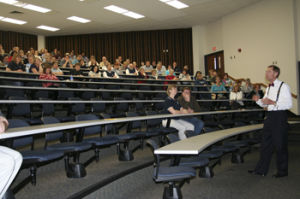University addresses budget shortfalls
March 9, 2009
Washburn staff and faculty joined Washburn University president Jerry Farley for a second town hall meeting March 6. “The purpose of this afternoon is to have a conversation, to talk about the current financial situation as it relates to us here at Washburn University and to talk about things that we ought to consider,” said Farley. After Farley’s address, Wanda Hill, vice president of administration and treasury, explained the sources of Washburn’s 2009 General Fund Budget, “Tuition $40 million [52 percent], State Operating Grant $12.5 million [16 percent], Sales Tax $18 million [23 percent] and other sources 9 percent.” These revenues are declining. Enrollment is down 8,000 hours, or $1.6 million. “Every loss of 100 students at 12 hours each represents $236,400,” said Hill. Proposed cuts to the state operating grant range from a half million to 2 million dollars. Sales tax revenues are holding so far this year, but December’s revenue was down $400,000.To keep pace with some of the losses in revenue, Washburn has already identified $2.6 million in budget cuts, but it needs to identify another $713,226. Early retirement has been suggested as a solution, and utility conservation has been instituted, but it may not be enough. “The reality is 75 percent, or a little better, of our total budget is salaries and wages,” said Hill. “The more we have to cut, the less flexibility we have because it is such a large part of our budget.”The floor was then open for audience participation. Questioned about tuition rates, Farley repeated statements he had made several times previously. “Our board said we are not going to increase tuition to offset losses in revenue,” said Farley. One faculty member questioned the cost of the Washburn Transformational Experience to the university and its effect on enrollment. “I don’t know [the effect] for sure,” said Farley. “There has not been enough time to determine whether [the WTE] is good or bad.”A variety of cost cutting suggestions were offered ranging from controlling the heat in stadium bathrooms to shortening the work week. However, Farley said the end solution may be much less pleasant than many had hoped. “We have to talk about the 75 percent [salaries and benefits] represents,” said Farley. “Layoffs would be dreadful but they may be what we have to do.”No doubt was left that future employment, wages and benefits were on the discussion table and that increasing enrollment is a priority. Farley stressed that no decisions have been made yet, and further consideration and participation is needed. He wants to minimize any impact to student education, support or services.



